Abstract
Nociceptive tail flick latencies (TFL) were recorded in response to noxious thermal stimuli applied to lightly anaesthetized rats. The effects of intrathecally administered dopamine receptor agonists alone and combined with dopamine receptor antagonists were examined upon the TFL. Experiments were repeated on animals made supersensitive to dopamine following withdrawal from 28 day administration of haloperidol. In untreated animals the D2-receptor agonist LY 171555 and apomorphine produced an increase in TFL. In contrast, the Di-receptor agonist SKF 38393 had no significant effect on TFL. TFL. Following haloperidol-induced dopamine-supersensitivity, SKF 38393 produced an increase in TFL. In contrast, LY171555 and apomorphine had minimal effects on TFL in this preparation. In animals not treated with haloperidol, the dopamine receptor antagonists SCH 23390 and (+/-)-sulpiride both blocked the increase in TFL produced by the D2-agonists. SCH23390 and (+/-)-sulpiride also blocked the increase in TFL produced by SKF 38393 in haloperidol-supersensitized animals. The antinociceptive action of intrathecally administered dopamine agonists appears to be mediated via D2-receptors. Whether the antinociception produced by SKF 38393 is exclusively contingent upon the activation of D1-receptors in the dopamine-supersensitive animal is as yet unresolved.
Full text
PDF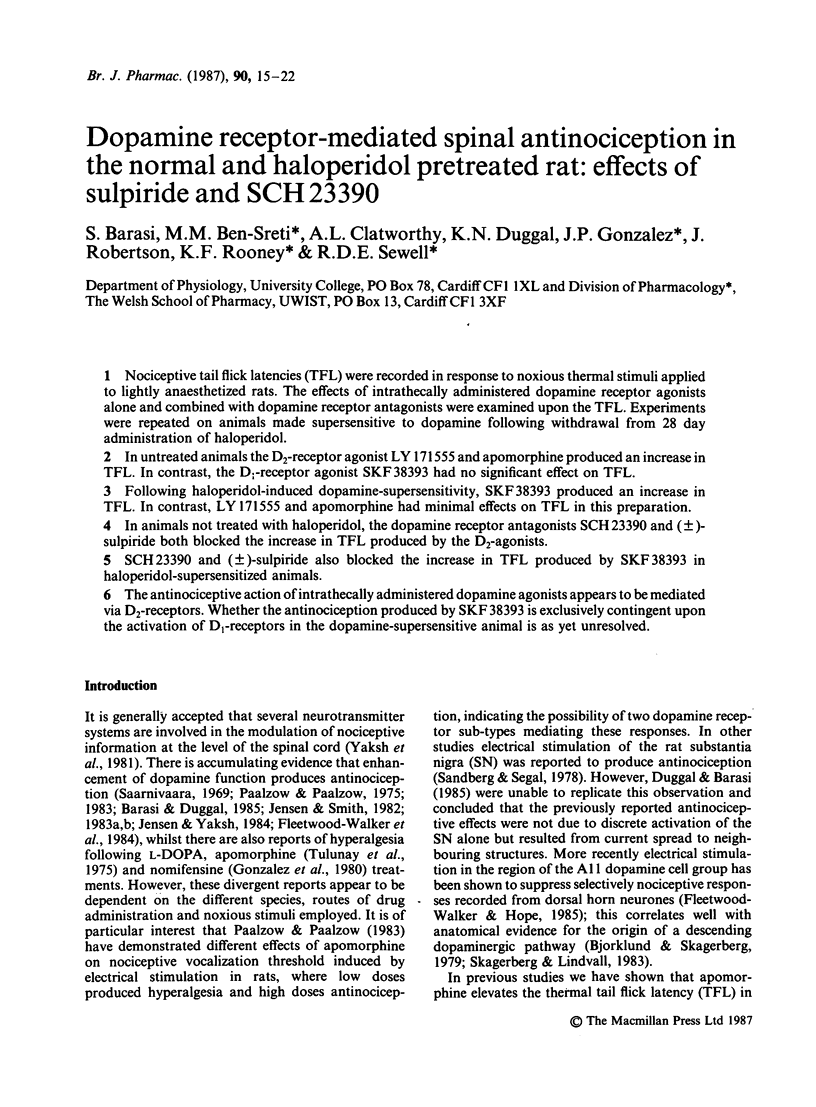
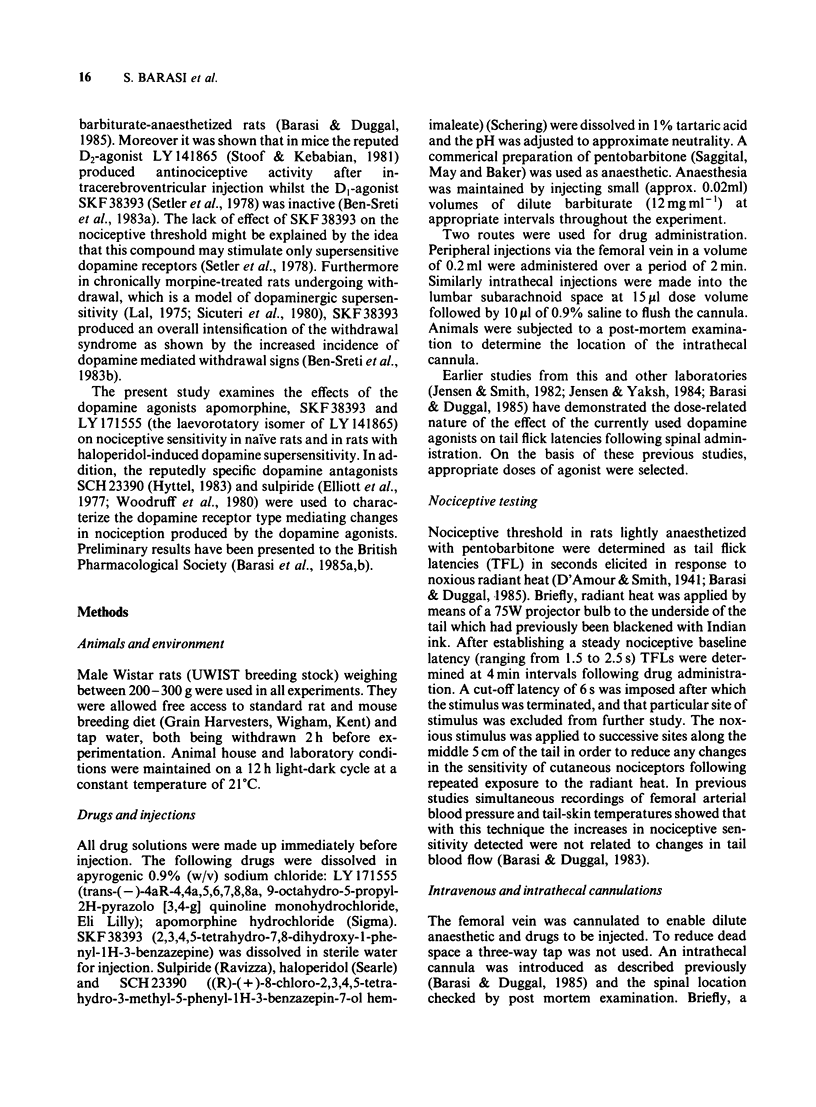
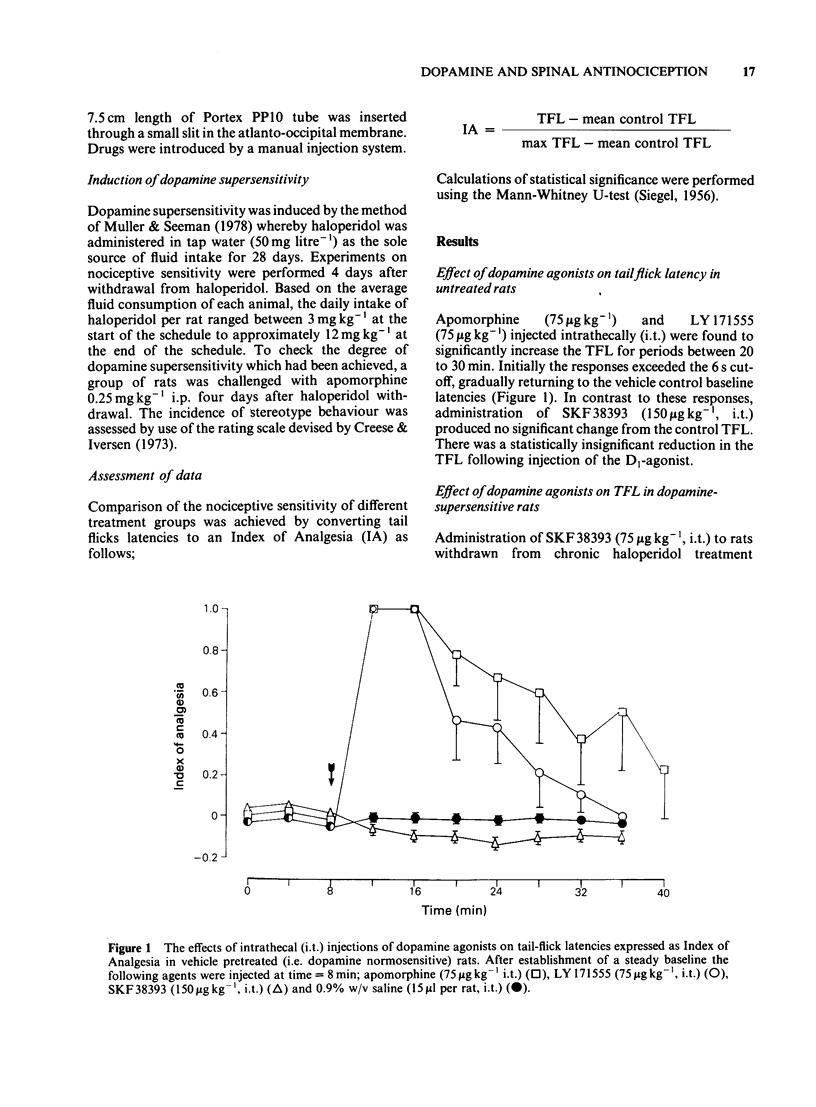
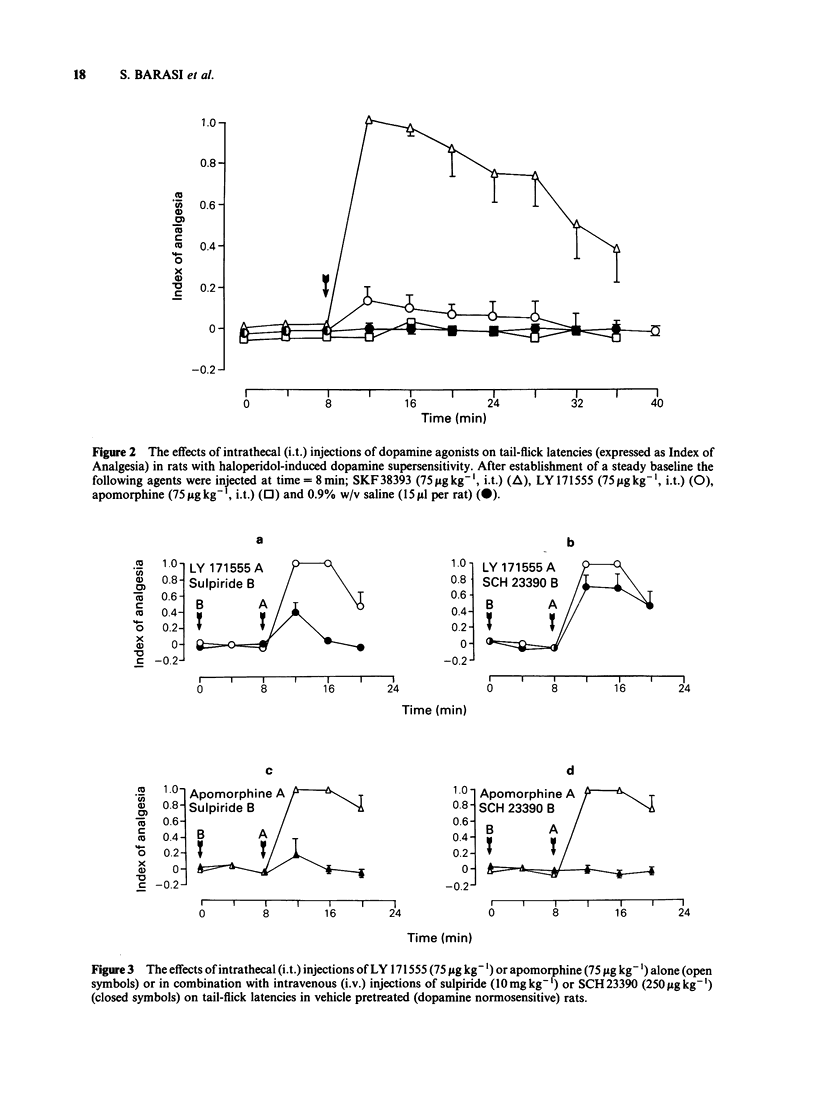
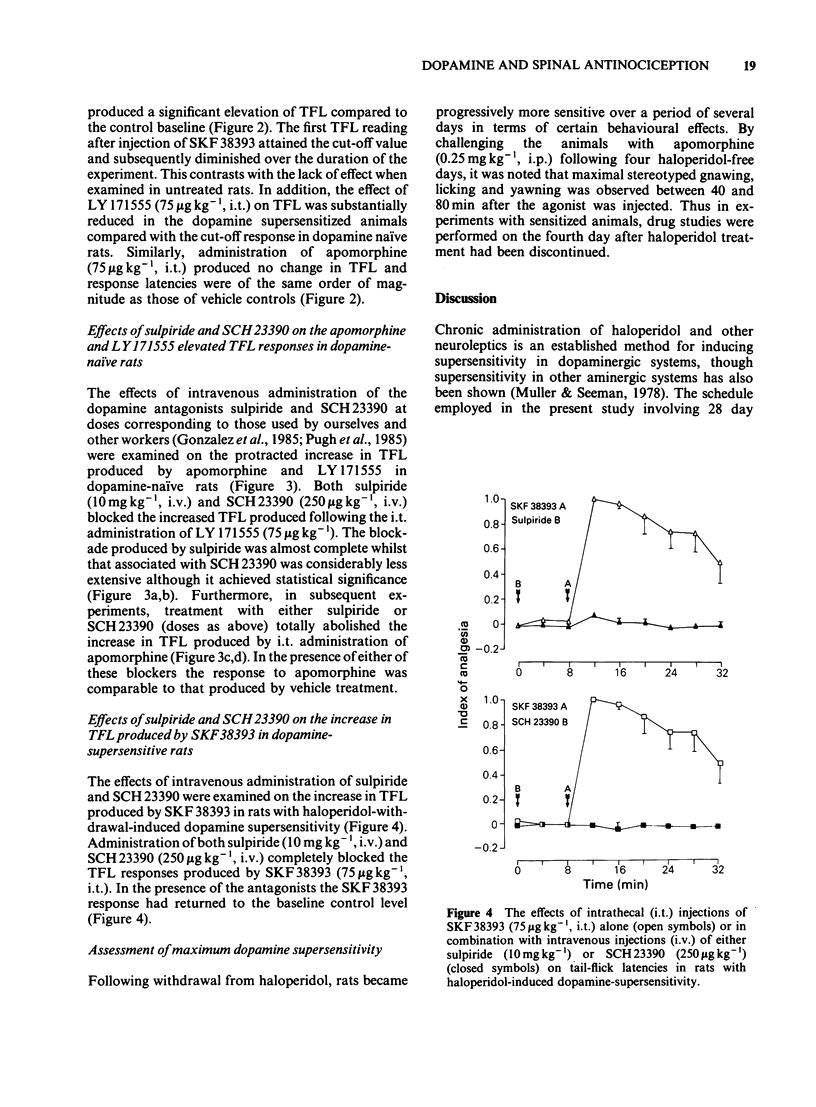
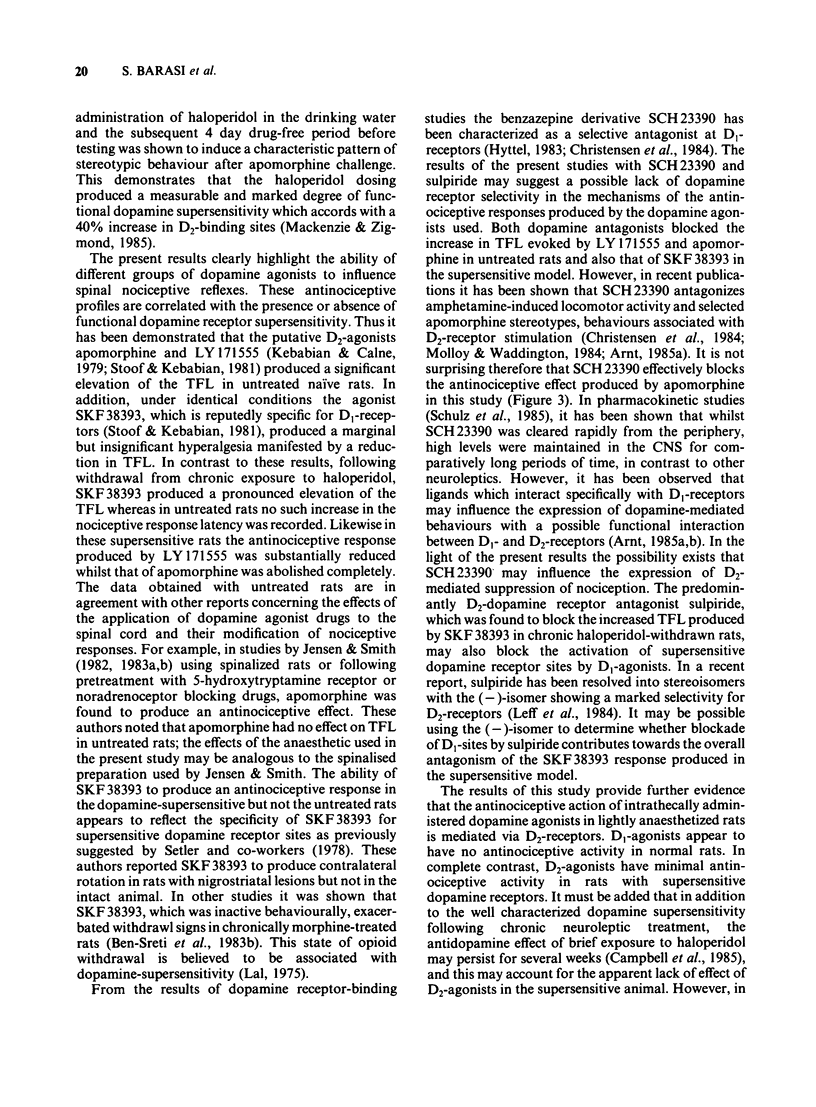
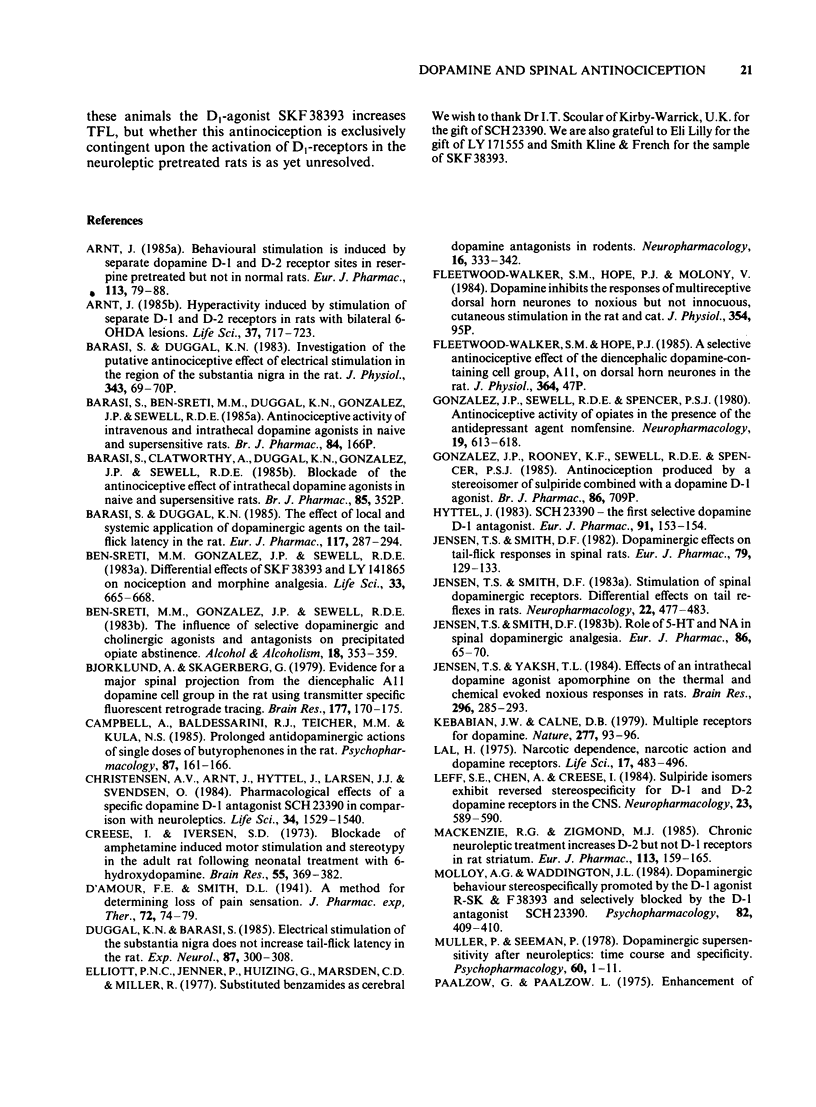
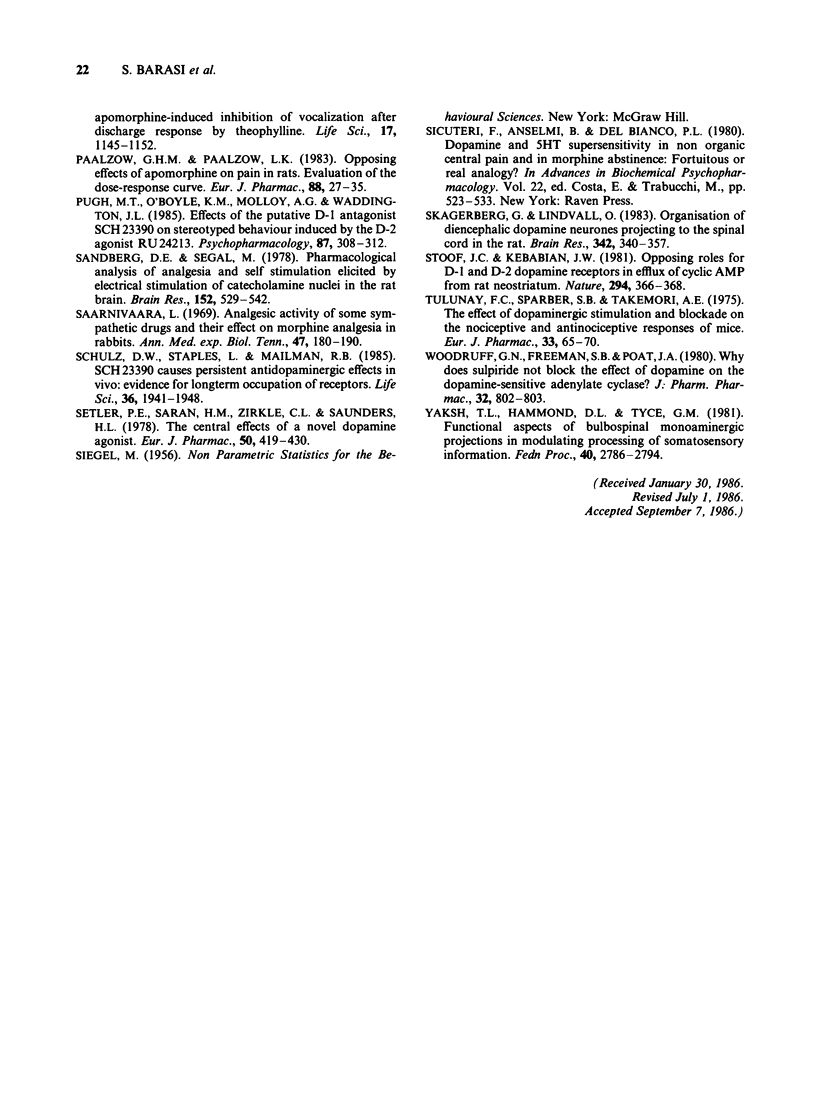
Selected References
These references are in PubMed. This may not be the complete list of references from this article.
- Arnt J. Behavioural stimulation is induced by separate dopamine D-1 and D-2 receptor sites in reserpine-pretreated but not in normal rats. Eur J Pharmacol. 1985 Jul 11;113(1):79–88. doi: 10.1016/0014-2999(85)90345-0. [DOI] [PubMed] [Google Scholar]
- Arnt J. Hyperactivity induced by stimulation of separate dopamine D-1 and D-2 receptors in rats with bilateral 6-OHDA lesions. Life Sci. 1985 Aug 26;37(8):717–723. doi: 10.1016/0024-3205(85)90541-7. [DOI] [PubMed] [Google Scholar]
- Barasi S., Duggal K. N. The effect of local and systemic application of dopaminergic agents on tail flick latency in the rat. Eur J Pharmacol. 1985 Nov 19;117(3):287–294. doi: 10.1016/0014-2999(85)90001-9. [DOI] [PubMed] [Google Scholar]
- Ben-Sreti M. M., Gonzalez J. P., Sewell R. D. Differential effects of SKF 38393 and LY 141865 on nociception and morphine analgesia. Life Sci. 1983;33 (Suppl 1):665–668. doi: 10.1016/0024-3205(83)90590-8. [DOI] [PubMed] [Google Scholar]
- Björklund A., Skagerberg G. Evidence for a major spinal cord projection from the diencephalic A11 dopamine cell group in the rat using transmitter-specific fluorescent retrograde tracing. Brain Res. 1979 Nov 9;177(1):170–175. doi: 10.1016/0006-8993(79)90927-2. [DOI] [PubMed] [Google Scholar]
- Campbell A., Baldessarini R. J., Teicher M. H., Kula N. S. Prolonged antidopaminergic actions of single doses of butyrophenones in the rat. Psychopharmacology (Berl) 1985;87(2):161–166. doi: 10.1007/BF00431801. [DOI] [PubMed] [Google Scholar]
- Christensen A. V., Arnt J., Hyttel J., Larsen J. J., Svendsen O. Pharmacological effects of a specific dopamine D-1 antagonist SCH 23390 in comparison with neuroleptics. Life Sci. 1984 Apr 16;34(16):1529–1540. doi: 10.1016/0024-3205(84)90607-6. [DOI] [PubMed] [Google Scholar]
- Creese I., Iversen S. D. Blockage of amphetamine induced motor stimulation and stereotypy in the adult rat following neonatal treatment with 6-hydroxydopamine. Brain Res. 1973 Jun 15;55(2):369–382. doi: 10.1016/0006-8993(73)90302-8. [DOI] [PubMed] [Google Scholar]
- Duggal K. N., Barasi S. Electrical stimulation of the substantia nigra does not increase tail-flick latency in the rat. Exp Neurol. 1985 Feb;87(2):300–308. doi: 10.1016/0014-4886(85)90220-1. [DOI] [PubMed] [Google Scholar]
- Elliott P. N., Jenner P., Huizing G., Marsden C. D., Miller R. Substituted benzamides as cerebral dopamine antagonists in rodents. Neuropharmacology. 1977 May;16(5):333–342. doi: 10.1016/0028-3908(77)90070-3. [DOI] [PubMed] [Google Scholar]
- Gonzalez J. P., Sewell R. D., Spencer P. S. Antinociceptive activity of opiates in the presence of the antidepressant agent nomifensine. Neuropharmacology. 1980 Jul;19(7):613–618. doi: 10.1016/0028-3908(80)90034-9. [DOI] [PubMed] [Google Scholar]
- Hyttel J. SCH 23390 - the first selective dopamine D-1 antagonist. Eur J Pharmacol. 1983 Jul 15;91(1):153–154. doi: 10.1016/0014-2999(83)90381-3. [DOI] [PubMed] [Google Scholar]
- Jensen T. S., Smith D. F. Dopaminergic effects on tail-flick response in spinal rats. Eur J Pharmacol. 1982 Apr 8;79(1-2):129–133. doi: 10.1016/0014-2999(82)90584-2. [DOI] [PubMed] [Google Scholar]
- Jensen T. S., Smith D. F. Stimulation of spinal dopaminergic receptors: differential effects on tail reflexes in rats. Neuropharmacology. 1983 Apr;22(4):477–483. doi: 10.1016/0028-3908(83)90166-1. [DOI] [PubMed] [Google Scholar]
- Jensen T. S., Yaksh T. L. Effects of an intrathecal dopamine agonist, apomorphine, on thermal and chemical evoked noxious responses in rats. Brain Res. 1984 Apr 2;296(2):285–293. doi: 10.1016/0006-8993(84)90064-7. [DOI] [PubMed] [Google Scholar]
- Kebabian J. W., Calne D. B. Multiple receptors for dopamine. Nature. 1979 Jan 11;277(5692):93–96. doi: 10.1038/277093a0. [DOI] [PubMed] [Google Scholar]
- Lal H. Narcotic dependence, narcotic action and dopamine receptors. Life Sci. 1975 Aug 15;17(4):483–495. doi: 10.1016/0024-3205(75)90081-8. [DOI] [PubMed] [Google Scholar]
- Leff S. E., Chen A., Creese I. Sulpiride isomers exhibit reversed stereospecificity for D-1 and D-2 dopamine receptors in the CNS. Neuropharmacology. 1984 May;23(5):589–590. doi: 10.1016/0028-3908(84)90034-0. [DOI] [PubMed] [Google Scholar]
- MacKenzie R. G., Zigmond M. J. Chronic neuroleptic treatment increases D-2 but not D-1 receptors in rat striatum. Eur J Pharmacol. 1985 Jul 17;113(2):159–165. doi: 10.1016/0014-2999(85)90732-0. [DOI] [PubMed] [Google Scholar]
- Molloy A. G., Waddington J. L. Dopaminergic behaviour stereospecific promoted by the D1 agonist R-SK & F 38393 and selectively blocked by the D1 antagonist SCH 23390. Psychopharmacology (Berl) 1984;82(4):409–410. doi: 10.1007/BF00427697. [DOI] [PubMed] [Google Scholar]
- Muller P., Seeman P. Dopaminergic supersensitivity after neuroleptics: time-course and specificity. Psychopharmacology (Berl) 1978 Dec 15;60(1):1–11. doi: 10.1007/BF00429171. [DOI] [PubMed] [Google Scholar]
- Paalzow G. H., Paalzow L. K. Opposing effects of apomorphine on pain in rats. Evaluation of the dose-response curve. Eur J Pharmacol. 1983 Mar 18;88(1):27–35. doi: 10.1016/0014-2999(83)90388-6. [DOI] [PubMed] [Google Scholar]
- Paalzow G., Paalzow L. Enhancement of apomorphine-induced inhibition of vocalisation afterdischarge response by theophylline. Life Sci. 1975 Oct 10;17(7):1145–1151. doi: 10.1016/0024-3205(75)90337-9. [DOI] [PubMed] [Google Scholar]
- Pugh M. T., O'Boyle K. M., Molloy A. G., Waddington J. L. Effects of the putative D-1 antagonist SCH 23390 on stereotyped behaviour induced by the D-2 agonist RU24213. Psychopharmacology (Berl) 1985;87(3):308–312. doi: 10.1007/BF00432713. [DOI] [PubMed] [Google Scholar]
- Saarnivaara L. Analgesic activity of some sympathetic drugs and their effect on morphine analgesia in rabbits. Ann Med Exp Biol Fenn. 1969;47(3):180–190. [PubMed] [Google Scholar]
- Sandberg D. E., Segal M. Pharmacological analysis of analgesia and self-stimulation elicited by electrical stimulation of catecholamine nuclei in the rat brain. Brain Res. 1978 Sep 8;152(3):529–542. doi: 10.1016/0006-8993(78)91108-3. [DOI] [PubMed] [Google Scholar]
- Schulz D. W., Staples L., Mailman R. B. SCH23390 causes persistent antidopaminergic effects in vivo: evidence for longterm occupation of receptors. Life Sci. 1985 May 20;36(20):1941–1948. doi: 10.1016/0024-3205(85)90443-6. [DOI] [PubMed] [Google Scholar]
- Setler P. E., Sarau H. M., Zirkle C. L., Saunders H. L. The central effects of a novel dopamine agonist. Eur J Pharmacol. 1978 Aug 15;50(4):419–430. doi: 10.1016/0014-2999(78)90148-6. [DOI] [PubMed] [Google Scholar]
- Sicuteri F., Anselmi B., Del Bianco P. L. Dopamine and 5-HT supersensitivity in nonorganic central pain and in morphine abstinence: fortuitous or renal analogy? Adv Biochem Psychopharmacol. 1980;22:523–533. [PubMed] [Google Scholar]
- Skagerberg G., Lindvall O. Organization of diencephalic dopamine neurones projecting to the spinal cord in the rat. Brain Res. 1985 Sep 9;342(2):340–351. doi: 10.1016/0006-8993(85)91134-5. [DOI] [PubMed] [Google Scholar]
- Stoof J. C., Kebabian J. W. Opposing roles for D-1 and D-2 dopamine receptors in efflux of cyclic AMP from rat neostriatum. Nature. 1981 Nov 26;294(5839):366–368. doi: 10.1038/294366a0. [DOI] [PubMed] [Google Scholar]
- Tulunay F. C., Sparber S. B., Takemori A. E. The effect of dopaminergic stimulation and blockade on the nociceptive and antinociceptive responses of mice. Eur J Pharmacol. 1975 Aug;33(1):65–70. doi: 10.1016/0014-2999(75)90139-9. [DOI] [PubMed] [Google Scholar]
- Woodruff G. N., Freedman S. B., Poat J. A. Why does sulpiride not block the effect of dopamine on the dopamine-sensitive adenylate cyclase? J Pharm Pharmacol. 1980 Nov;32(11):802–803. doi: 10.1111/j.2042-7158.1980.tb13077.x. [DOI] [PubMed] [Google Scholar]
- Yaksh T. L., Hammond D. L., Tyce G. M. Functional aspects of bulbospinal monoaminergic projections in modulating processing of somatosensory information. Fed Proc. 1981 Nov;40(13):2786–2794. [PubMed] [Google Scholar]


